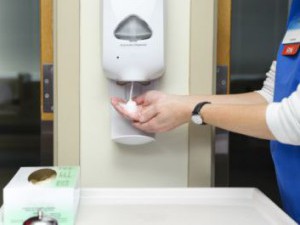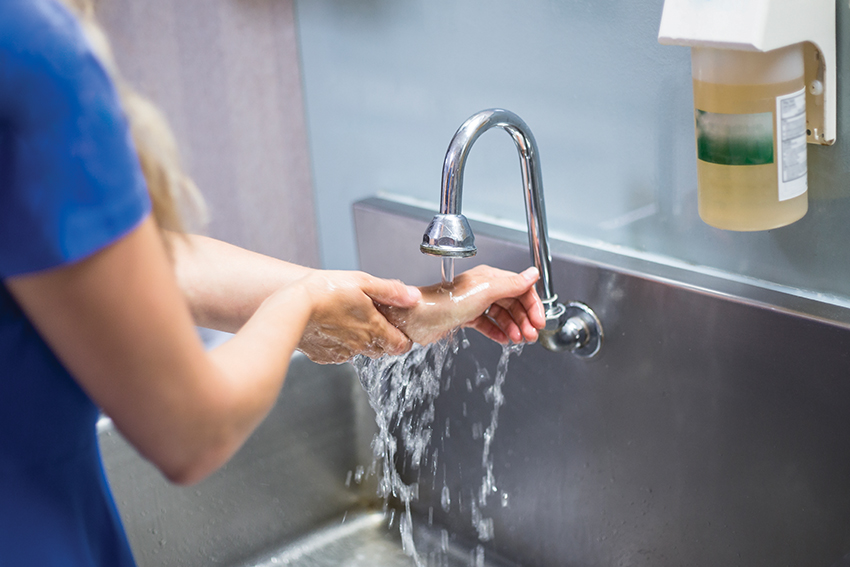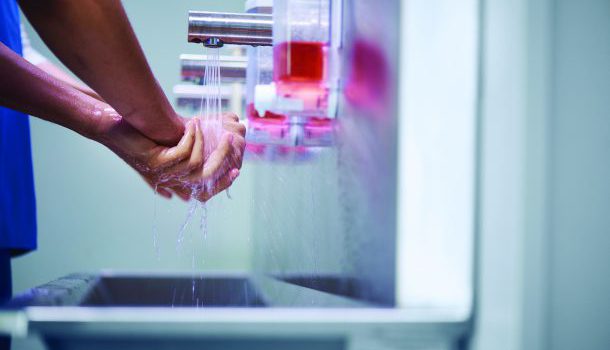
As many facility managers and cleaners return to business as usual after the pandemic, the big plea from infection-prevention experts and disinfection product distributors is that they do not forget one crucial element – hand hygiene.
Amid concerns that hand hygiene may fall off the radar in the post-pandemic era, there are some positive signs that many people are taking the issue seriously.
A new survey highlights the importance of hand hygiene in public spaces, with the Healthy Handwashing Survey from Bradley Corporation in the United States noting that people are still going out of their way to avoid contact with bacteria on surfaces and touchpoints.
The study reveals that 62 per cent of respondents use a paper towel as a barrier to avoid touching toilet flush buttons, taps and doors, with women, in particular, using paper towels as a ‘glove’ to protect themselves from germs and bugs.
Other actions include 43 per cent of people opting to use their foot to flush toilets, while 20 per cent use their elbow to operate paper towel dispensers.
Furthermore, the survey indicates that eight out of 10 respondents favour having touchless fixtures in a public restroom to improve hand hygiene, including through better technology for taps, flush buttons, soap dispensers and paper towel dispensers, in that order.
Such an emphasis on hand hygiene must be encouraged and further ramped up, according to Whiteley chairman Dr Greg Whiteley, one of the world’s most respected infection-prevention experts.
He warns that while many healthcare facilities are winding back the last of the pandemic’s restrictions, such as mandatory mask-wearing, the reality is that “there are more people dying now from COVID-19 than there were in the first phase of the pandemic”.
Dr Whiteley says heightened risk comes in the form of the explosion of ‘gram negative’ bacteria that are a major cause of healthcare-associated infections, or HAIs.
“These bugs are largely spread by touch and they’re fantastic biofilm producers and they move from place to place, surface to surface,” he says.
The threat they pose underlines the importance of proper hand hygiene, says Dr Whiteley, who cites research by the late Professor Mary-Louise McLaws* indicating that, despite hospitals claiming that they have a 90 per cent compliance rate with hygiene requirements, the true compliance rate is probably closer to 30 per cent.
“Let’s assume the best outcome and say that you’ve got a one in two chance that the healthcare professional who touched you has not washed their hands in accordance with World Health Organisation (WHO) and Australian requirements. That’s terrifying,” says Dr Whiteley, who adds that infection of wounds through poor hygiene can be life-threatening.
Paper trail
The reliance on paper towels for hand hygiene, identified in the Healthy Handwashing Survey, comes as no surprise to Michelle Hood, commercial strategy, and marketing manager at SolarisPaper, which distributes high-quality toilet and tissue products.
Two years ago, Solaris Paper launched its Sorbent Professional line of paper products to complement the company’s business-to-business brand, Livi.
Hood says the knowledge that best practice hand-hygiene “ends with dry hands” is encouraging people to use paper towels and has contributed to overall sales growth for Solaris Paper. “Paper towel is the fastest way to dry hands and the germs can be binned, rather than being blown around the room by air driers,” she says.
Hood says dispenser systems in restrooms are also an important practical component of the battle to boost better hand hygiene. While some facilities are embracing technology and turning to mechanised dispenser systems, they can have drawbacks.
“Mechanised dispensers and touch-free dispensers are great when they work, but we believe that the manual dispensers remain the most durable and effective over the long term,” Hood says.
For restrooms, the emphasis is on high-capacity dispensers that last.
“Looks are great, but if the dispenser is not robust then the business will be constantly replacing them due to damage,” Hood days. “It’s also important that dispensers have a viewing window so cleaning staff can see how much is left in the unit without having to open each one, therefore saving time.”
Poor hand-washing habits aside, Dr Whiteley says the other elephant in the room with hand hygiene is the improper use of gloves.
“Most people wear gloves as though it’s going to be a force field to protect them,” he says.
With gloves often becoming the means by which bugs move from place to place, Dr Whiteley says the rule of thumb – whether reusable or stronger vinyl gloves are being worn – is to use an alcohol-based hand rub as often as possible.
“Either that, or you change your gloves. Of course, no one gives cleaners enough money to change their gloves often enough, but if they can wash their hands, or wash their gloves, that’s a good outcome.”
On the product front, Dr Whiteley says it is important for facility managers to know that at the top end there are alcohol-based hand rubs and other antimicrobial hand rubs that are registered by the Therapeutic Goods Administration in Australia, or Medsafe New Zealand.
“These products are registered as medicines, so there are very strict manufacturing controls and very strict efficacy requirements. Basically, this means when you use those products, you’ve got a safety guarantee or a quality guarantee out in the general marketplace.”
For home-based hand cleaning, old-fashioned soap is usually fine. However, after emptying bed pans or cleaning up bodily fluids in a healthcare setting, Dr Whiteley says it is crucial to wear PPE gear, including gloves, and to use an approved hand-hygiene product.
“During COVID-19, every man and his dog wanted to make alcohol-based hand rubs. And there was a lot of cheap rubbish that came in from overseas and most of it will destroy your skin.”
With the Livi soap and sanitiser range, Hood says there was a huge upswing in sales at the beginning of COVID-19 “when we were all desperate to protect ourselves from an unknown threat”.
“By 2022, every gin distiller was making hand sanitiser, so we ended up with a glut in the market and all that product has now expired. Things have returned to the new normal for us, with sales trending above 2022.”
She acknowledges the importance of having hand-hygiene products that break germ transmission while not irritating sensitive, frequently washed hands.
“Hand-hygiene compliance in businesses is a critical part of keeping everyone well enough to work,” Hood says. Practices that have made a difference include:
- installing signage in restrooms that explain best-practice hygiene approaches
- washing hands with soap for at least 20 seconds and drying them thoroughly, as wet hands spread bacteria more widely
- recognising that moisture can promote bacterial growth, which puts a premium on using paper towels due to their single-use nature, high absorbency, and ease of disposal.
A smart investment
A recent report from the WHO suggests that HAIs are all too common in the context of health-service delivery and represent a threat to the health of people around the world.
The study reveals that out of every 100 patients in acute-care hospitals, seven patients in high-income countries and 15 patients in low- and middle-income countries will acquire at least one HAI during their hospital stay.
The WHO states that there is “compelling evidence” that infection-prevention and control programs, including hand hygiene practices, can achieve a 35 per cent to 70 per cent reduction in the rates of HAIs. It estimates that improving hand hygiene in healthcare settings represents an excellent return on investment, potentially saving up to US$16.50 in healthcare expenditure for every US$1 spent.
While much of the hand-hygiene focus is rightly directed at elements such as antiseptic hand rubs and the most effective dispenser solutions, Dr Whiteley says there is one hallmark of healthcare facilities that exhibit best practice – culture. This includes proper training of staff on hygiene practices and communicating hand-hygiene rules and regulations to visitors at healthcare facilities.
He points to published research by his team showing that once a person touches biofilms and gets bugs on their fingers, those bugs will stay on hands for up to 19 subsequent touches.
“If you don’t clean surfaces properly, the biofilms and the bugs remain. So, you’ve got to have effective cleaning, but you’ve really got to make sure you’ve also got effective hand-hygiene compliance. A good culture reinforces it, and there’s a lot to be said for a broader and more widespread understanding of the need for the right culture when it comes to hand hygiene.”
This article first appeared in INCLEAN magazine




